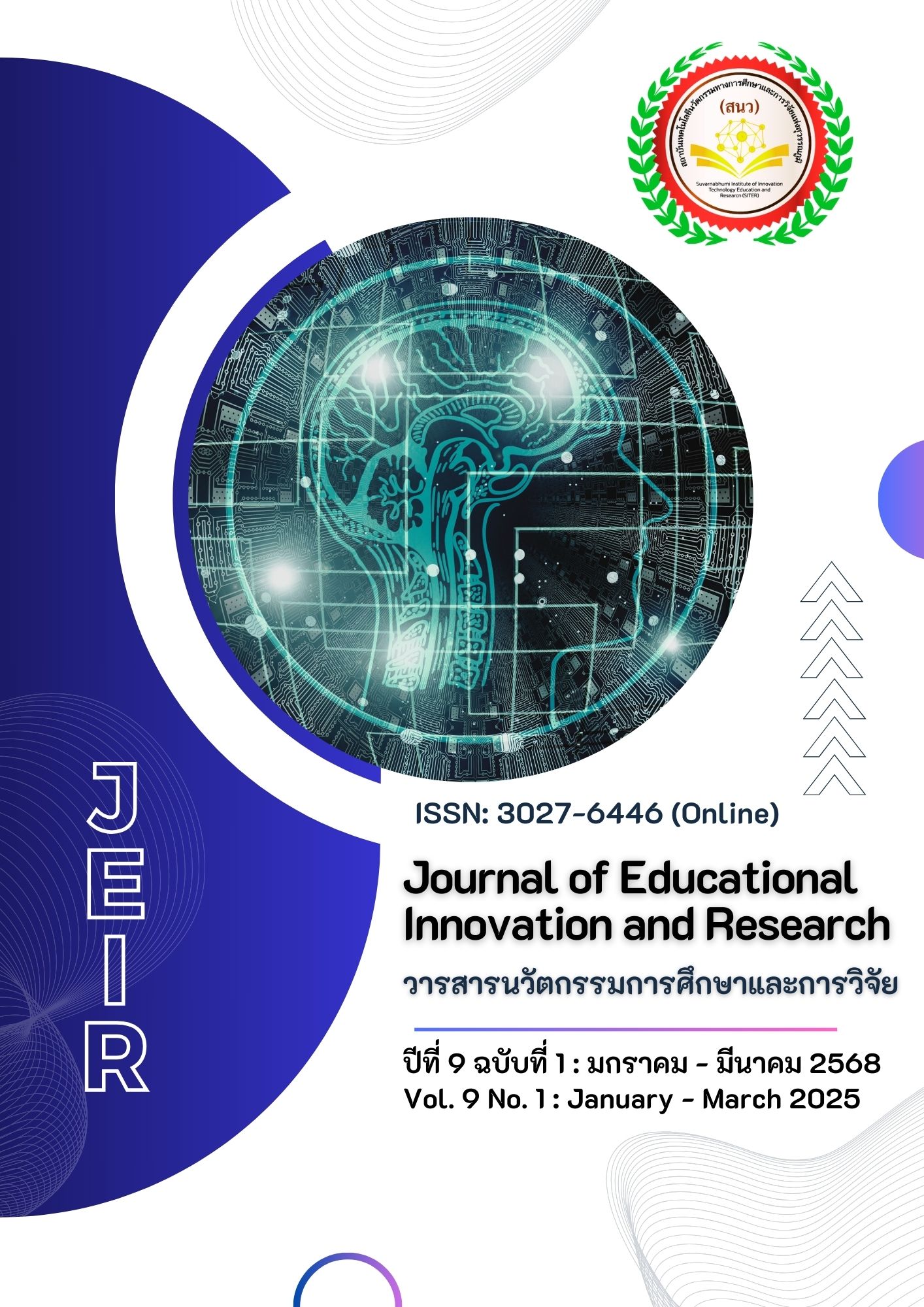Confirmatory Factor Analysis of Repurchase Intention during Online Shopping Festivals in Thailand
Main Article Content
Abstract
This study aims to 1) develop a confirmatory structure of repurchase intention in online shopping festivals in Thailand, and 2) investigate the fit of the confirmatory structure of repurchase intention in online shopping festivals in Thailand. The research employed a quantitative approach using confirmatory factor analysis (CFA) as the analytical framework. The research setting was Thailand, and the sample consisted of 340 experienced online shopping festival participants with at least six months of online shopping experience within Thailand. Data were collected using an online questionnaire.
The findings reveal that the repurchase intention in online shopping festivals in Thailand comprises four dimensions: 1) corporate social responsibility communication (CSRC), 2) perceived quality (PQ), 3) brand loyalty (BL), and 4) repurchase intention (RI). The results demonstrate a statistically significant fit between the proposed model and the empirical data at the .01 level for all indicators.
These findings serve as a foundation for researchers and practitioners to further develop marketing strategies in the dimensions of corporate social responsibility communication, building brand quality perception, fostering brand loyalty, and driving repurchase behavior in online shopping festivals in Thailand.
Article Details

This work is licensed under a Creative Commons Attribution-NonCommercial-NoDerivatives 4.0 International License.
References
Aaker, D. A. (1991). Managing brand equity: Capitalizing on the value of a brand name. Free Press.
Aaker, D. A. (1996). Measuring brand equity across products and markets. California Management Review, 38(3), 102-20.
Al-Falahy, N., & Alani, O. (2018, February 13). Improved Capacity and Fairness of Massive MaChine Type Communications in Millimeter Wave 5G Network. Computers, 7(1), 16.
Aquinia, A., SoLiha, E., Liana, L., & Wahyudi, D. (2021, March 13). The role of perceived quaLity and brand loyalty influencing repurchase intention. Advances in Economics, Business and Management Research, 145(1), 76-82.
Baldinger, A.L., & Rubinson, J. (1996). Brand loyalty: The Link between attitude and behavior. Journal of Advertising Research, 36, 22-34.
Breves, P. L., Liebers, N., Abt, M., & Kunze, A. (2019). The perceived fit between Instagram influencers and the endorsed brand: How influencer–brand fit affects source credibility and persuasive effectiveness. Journal of Advertising Research, 59(4), 542-557.
Chi, Y. H., Yeh, C. H., & Yang, S. H. (2009). The impact of brand awareness on consumer purchase intention: The mediating effect of perceived quality and brand loyalty. Journal of International Management Studies, 4(1), 135-144.
Durana, P., Majerova, J., & Mišanková, M. (2019). The Quality of Brand Products: Expected Attributes vs. Perceived ReaLity. Economics and Culture, 16(1), 98-107.
Engel, J. F. Blackwell, R. D., & Miniard, P. W. (1995). Consumer behavior (8th ed.) The Dryden.
Fishbein, M., & Ajzen, I. (1975). Belief, attitude, intention, and behavior: an introduction to theory and research. Addison-Wesley
Hair, J. F., Black, W. C., Babin, B. J., & Anderson, R. E. (2010). Multivariate Data Analysis. 7th Edition. Prentice Hall.
Kamboh, M. A., ALi, S., Mahmood, A., & Kamboh, A. Z. (2020). The Brand Loyalty. DOI: 10.13140/RG.2.2.12432.15369
Kim, J. J., Kim, H. M., & HWang, J. (2022). Consequences of brand modernity in the coffee industry: The moderating role of human barista and robot barista. Journal of Hospitality and Tourism Technology, https://www.emerald.com/insight/content/doi/10.1108/JHTT-08-2021-0239/full/html?skipTracking=true
Koernig, S. K., & Boyd, T. C. (2009). To catch a tiger or let him go: The match-up effect and athlete endorsers for sport and non-sport brands. Sport Marketing Quarterly, 18(1), 25-37.
Kotler, P. (2003). Marketing Management (11th ed.). New Jersey: Prentice Hall.
Li, J., Zhu, A., Liu, D., Zhao, W., Zhou, Y., Chen, Y., Liu, Y., & Sun, N. (2020). Sustainability of China’s Singles Day Shopping Festivals: Exploring the Moderating Effect of Fairness Atmospherics on Consumers’ Continuance Participation. Sustainability, 12(7), 2644.
Lyu, L., Zhai, L., Boukhris, M., & Akbar, A. (2023). Impact of corporate social responsibility practices on impulse buying intention: Exploring the moderating influence of social media advertising. SustainabiLity, 15(23), 16258.
Mann, M., Byun, S. E., & Ginder, W. (2021). B Corps’ Social Media Communications during the COVID-19 Pandemic: Through the Lens of the Triple Bottom Line. Sustainability, 13(17), 1-21.
Mitra, D., & Golder, P. N. (2006, May). How does objective quality affect perceived quality? Short-term effects, long-term effects, and asymmetries. Marketing Science, 25(3), 230-247.
MOHR, L. A., WEBB, D. J., & HARRIS, K. E. (2001). Do Consumers Expect Companies to be Socially Responsible? The Impact of Corporate Social Responsibility on Buying Behavior. The Journal of Consumer Affairs, 35(1), 45–72.
MoLinillo, S., Japutra, A., & Ekinci, Y. (2022). Building brand credibility: The role of involvement, identification, reputation, and attachment. Journal of Retailing and Consumer Services, 64(C), 102819.
Mowen, J. C., & Minor, M. (2001). Consumer behavior: A framework (2nd ed.). Prentice-Hall.
OLiver, Richard L. (1999). Whence Consumer Loyalty?. Journal of Marketing, 63, 33-44.
Princes, E., Manurung, A. H., So, I. G., & Abdinagoro, S. B. (2020). The Next Level of Purchase Intention. https://www.researchgate.net/pubLication/341651124_The_Next_Level_of_Purchase_Intention
Schneewind, A., & Sharkasi, N. (2022). Analysis of the Impact of Brand Fit on Perceived CredibiLity of Social Media Influencers by European Millennials. Advances in Digital Marketing and eCommerce (pp. 191-207). Tokyo International University. DOI: 10.1007/978-3-031-05728-1_22
Shahmohammadi, S., SteinMann, Z. J. N., Tambjerg, L., van Loon, P., King, H. M., & Huijbregts, M. A. J. (2020). Comparative greenhouse gas foot printing of online versus traditional shopping for fast-moving consumer goods: A stochastic approach. Environmental Science & Technology, 3499-3509. https://doi.org/10.1021/acs.est.9b06252
Statista. (2023, March 14). Thailand: Number of monthly web visits to Lazada, by quarter. Retrieved from https://www.Statista.com/statistics/1007132/Thailand-number-monthly-web-visits-lazada-quarter/
Statista. (2023, March 14). Thailand: Number of monthly web visits to Shopee, by quarter. Retrieved from https://www.Statista.com/statistics/1007161/Thailand-number-monthly-web-visits-shopee-quarter/
Wang, Y. J., Minor, M. S., & Wei, J. (2010). Aesthetics and the online shopping environment: Understanding consumer responses. Journal of Retailing, 86(4), 439-450.
Wijarnoko, M. A., Pramana, E., & Santoso, J. (2023). Factors That Influence Repurchase Intention: A Systematic Literature Review. Teknika, 12(3), 252-260.
Xie, J., Yoon, N., & Choo, H. J. (2023). How online shopping festival atmosphere promotes consumer participation in China. Fashion and Textiles, 10(5), 1–12.

